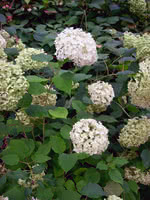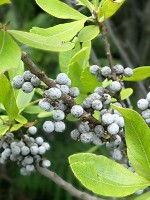Mon-Fri 9am - 5pm Mountain time
Annabelle Hydrangea vs Northern Bayberry
Hydrangea arborescens Annabelle
Myrica pensylvanica
NOT AVAILABLE THIS SEASON - MIGHT RETURN
Annabelle Hydrangea is a cold hardy shrub that is well known for its large, compact clusters of white flowers. Unlike other flowering species, Hydrangeas do best in partial shade. However, they are capable of growing in full sun if the soil is kept consistently moist.
Blooms occur on new wood, so regular pruning is encouraged in late winter. Try Annabelle Hydrangea as a border or on its own.
Northern Bayberry makes an excellent hedge or feature shrub. It will retain its leaves in warmer climates but drops them in colder areas. They produce blue-grey berries that have a wax coating on them that can be used to make candles or soaps.
In colder hardiness zones the leaves turn an attractive orange to red colour in the fall, making it a striking addition to your landscape.
Northern Bayberry is native to Nova Scotia and tolerates both drought and wet conditions. It is also a nitrogen fixer that tolerates poor soil conditions.
Annabelle Hydrangea Quick Facts
Northern Bayberry Quick Facts
Toxicity: Warning: The wax from bayberry fruit is considered toxic and may be carcinogenic.

